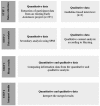Access to Difficult-to-reach Population Subgroups: A Family Midwife Based Home Visiting Service for Implementing Nutrition-related Preventive Activities - A Mixed Methods Explorative Study
- PMID: 29546123
- PMCID: PMC5690248
- DOI: 10.3934/publichealth.2015.3.516
Access to Difficult-to-reach Population Subgroups: A Family Midwife Based Home Visiting Service for Implementing Nutrition-related Preventive Activities - A Mixed Methods Explorative Study
Abstract
Health and social inequality are tightly linked and still pose an important public health problem. However, vulnerable and disadvantaged populations are difficult to reach for health-related interventions. Given the long-lasting effects of an adverse, particular nutrition-related, intrauterine and neonatal environment on health development (perinatal programming), an early and easy access is essential for sustainable interventions. The goal of this explorative study was therefore to elucidate whether an existing access of family midwives (FMs) to families in need of support could be an option to implement effective public health and nutrition interventions. To that end three research objectives were formulated: (1) to determine whether a discernible impact of home visits by FMs can be described; (2) to identify subgroups among these families in need of more specific interventions; (3) to determine how relevant nutrition-related topics are for both FMs and the supported families. For addressing these objectives a mixed methods design was used: Routine documentation data from 295 families visited by a family midwife (FM) were analyzed (secondary analysis), and structured expert interviews with FMs were conducted and analyzed. Study reporting followed the STROBE (STrengthening the Reporting of OBservational studies in Epidemiology) statement. Based on the FMs reports, a significant improvement (p < 0.001) regarding psycho-social variables could be determined after the home visits. Single mothers, however, seemed to benefit less from the FMs service compared to their counterparts (p = 0.015). Nutritional counseling was demanded by 89% of the families during the home visits. In addition, nutrition-related topics were reported in the interviews to be of high interest to both families and the FMs. Based on the obtained results it is concluded that FMs home visits offer a promising access to vulnerable and disadvantaged families for implementing nutrition-related preventive activities.
Keywords: child health services; family research; health inequality; home visiting services; midwifery; perinatal programming; public health; socioeconomic factors.
Conflict of interest statement
Conflict of Interest: All authors declare no conflicts of interest.
Figures


Similar articles
-
Key role in the prevention of child neglect and abuse in Germany: continuous care by qualified family midwives.Midwifery. 2012 Aug;28(4):E469-77. doi: 10.1016/j.midw.2011.05.009. Epub 2011 Jul 23. Midwifery. 2012. PMID: 21782297
-
From concept to application: the impact of a community-wide intervention to improve the delivery of preventive services to children.Pediatrics. 2001 Sep;108(3):E42. doi: 10.1542/peds.108.3.e42. Pediatrics. 2001. PMID: 11533360 Clinical Trial.
-
Hawaii's healthy start home visiting program: determinants and impact of rapid repeat birth.Pediatrics. 2004 Sep;114(3):e317-26. doi: 10.1542/peds.2004-0618. Pediatrics. 2004. PMID: 15342892 Clinical Trial.
-
Structured social relationships: a review of volunteer home visiting programs for parents of young children.Aust Health Rev. 2016 Jun;40(3):262-269. doi: 10.1071/AH15057. Aust Health Rev. 2016. PMID: 26456798 Review.
-
A theory of maternal engagement with public health nurses and family visitors.J Adv Nurs. 2005 Jan;49(2):182-90. doi: 10.1111/j.1365-2648.2004.03278.x. J Adv Nurs. 2005. PMID: 15641951 Review.
Cited by
-
Mixed Methods Studies Using Secondary Analysis in Nursing and Midwifery: A Methodological Review.J Adv Nurs. 2025 May;81(5):2316-2332. doi: 10.1111/jan.16557. Epub 2024 Nov 18. J Adv Nurs. 2025. PMID: 39558585 Free PMC article.
-
Preuse Acceptance of a Family-Centered, Need-Based, and Interprofessional Perinatal Care Mobile Health Intervention: Exploratory Study.JMIR Hum Factors. 2025 Jun 12;12:e66658. doi: 10.2196/66658. JMIR Hum Factors. 2025. PMID: 40505134 Free PMC article.
References
-
- Dalstra J. Socioeconomic differences in the prevalence of common chronic diseases: an overview of eight European countries. Int J Epidemiol. 2005;34(2):316–326. - PubMed
-
- Berkman LF. Social Epidemiology: Social Determinants of Health in the United States: Are We Losing Ground? Annu Rev Publ Health. 2009;30(1):27–41. - PubMed
-
- Friel S, Marmot MG. Action on the Social Determinants of Health and Health Inequities Goes Global. Annu Rev Publ Health. 2011;32(1):225–36. - PubMed
LinkOut - more resources
Full Text Sources
Other Literature Sources
Miscellaneous
